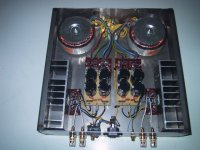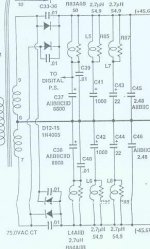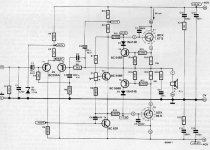janneman said:I feel strongly about this. I hate to be manipulated, even by myself.
Have you considered that your strong feelings may facilitate self manipulation? (Not intended as a joke.)
If you strongly feel there can be no difference, how will you ever hear a difference even in a blind test? The sword of listener bias cuts both ways.
Hmmmm, this one I do not buy:
It is so very easy to try the idea of CarlosFM. Actually I searched the web on PSU building. All my findings pointed to CarlosFM's ideas! I will not claim that he invented it, but he did bring the facts to our attention. No doubt, whatsoever about that🙂
I have build several chipamps, and none of them was as good as those with CarlosFM's "snupper'd" PSU's. Very tight bass, in comparison to a generic chipamp. I really didn't like chipamps until I listened to this one. (See pic). I made 2 of those for a friend.
He is very happy about it🙂
In fact, I feel strongly, that is all, this is about!Nobody is which-hunting.
It is so very easy to try the idea of CarlosFM. Actually I searched the web on PSU building. All my findings pointed to CarlosFM's ideas! I will not claim that he invented it, but he did bring the facts to our attention. No doubt, whatsoever about that🙂
I have build several chipamps, and none of them was as good as those with CarlosFM's "snupper'd" PSU's. Very tight bass, in comparison to a generic chipamp. I really didn't like chipamps until I listened to this one. (See pic). I made 2 of those for a friend.
He is very happy about it🙂
Attachments
moving_electron said:Early in this thead there was a question on whether the regulated supply could benefit also from this approach. I don't think it got addressed.
What impedence characteristics are likely/typically added by the regulator (LM338 for example)?
What does this tend to look like to the chipamp?
In CarlosFM's regulated supply values he has a 47nF cap at the output of the LM338 (near the reg.) and a 33uF-100uF cap at the LM3886. I don't think there is a bypass cap on the 33uF-100uF cap at the Chipamp IIR. The power supply before the regulators was transformer>4700uF+4700uF>47uf.
Well, here we go again with metaphysics battling physics -- the problem with an off-the-shelf regulator is that the impedance changes with frequency --
Konnichiwa,
Correct, it is not Witchhunting, as a Witch is of Female gender, I suspect we would have to call it warlock hunting.
Finally we have reached the crux of the matter.
The issues are actually much deeper and there is a VERY VESTED interest from the Pseudo Objectivists. What vested interest you ask?
They have a larger part of their life invested into a particular worldview. In this worldview Cables make no audible difference, RC snubbers make no difference and the list goes on endlessly. And anyone having experiences to the contrary "is in on it". Anyone disagreeing is either deluded by "those multi-kilo dollar cable peddlers, brilliant pebbles, magic pens," or "makes a killing".
The problem with this worldview is that it absoltely cannot tolerate ANY invalidation in however samll a matter (such as the issues around PSU Line impedance & resonances that overtly are the topic here).
Because if such an overall, ironcast, rigid view is wrong in the least, it would require a full re-evaluation of what the individual has accepted ex cathedra, usually without any material evidence as dogmatic article of faith. Instead a regular, rigid and liberal application of doublethink and duckspeak is made.
So, we must forgive these poor deluded souls, after all, they only defend the orthodoxy of their particular religion, which also requires to burn warlocks at the stake and oppose, shariat like anything it dislikes, even in those who do not subscribe to the same religion....
As they man said when they nailed him to some wood, "...fro they do not know...". So we may happily forgive and forget. I'm sure they feel all better now given that the REAL reasons have finally been brought to light again.
Sayonara
janneman said:Nobody is which-hunting.
Correct, it is not Witchhunting, as a Witch is of Female gender, I suspect we would have to call it warlock hunting.
janneman said:That is exactly the way those multi-kilo dollar cable peddlers, brilliant pebbles, magic pens, whatever, etc make their killing.
Finally we have reached the crux of the matter.
The issues are actually much deeper and there is a VERY VESTED interest from the Pseudo Objectivists. What vested interest you ask?
They have a larger part of their life invested into a particular worldview. In this worldview Cables make no audible difference, RC snubbers make no difference and the list goes on endlessly. And anyone having experiences to the contrary "is in on it". Anyone disagreeing is either deluded by "those multi-kilo dollar cable peddlers, brilliant pebbles, magic pens," or "makes a killing".
The problem with this worldview is that it absoltely cannot tolerate ANY invalidation in however samll a matter (such as the issues around PSU Line impedance & resonances that overtly are the topic here).
Because if such an overall, ironcast, rigid view is wrong in the least, it would require a full re-evaluation of what the individual has accepted ex cathedra, usually without any material evidence as dogmatic article of faith. Instead a regular, rigid and liberal application of doublethink and duckspeak is made.
So, we must forgive these poor deluded souls, after all, they only defend the orthodoxy of their particular religion, which also requires to burn warlocks at the stake and oppose, shariat like anything it dislikes, even in those who do not subscribe to the same religion....
As they man said when they nailed him to some wood, "...fro they do not know...". So we may happily forgive and forget. I'm sure they feel all better now given that the REAL reasons have finally been brought to light again.
Sayonara
rc damping equivalent
Instead of this rc damping, one could also add progressively smaller caps with the assumption that the inductances get smaller as you decrease the cap value. Doing it this way will suppress the impedance peaks and push the eventual 2pi*f*L to a much higher frequency. Of couse if you can get a single cap with no L, then theoretically, the reactance will always be lower as you increase in frequency.
My 2 cents.
Instead of this rc damping, one could also add progressively smaller caps with the assumption that the inductances get smaller as you decrease the cap value. Doing it this way will suppress the impedance peaks and push the eventual 2pi*f*L to a much higher frequency. Of couse if you can get a single cap with no L, then theoretically, the reactance will always be lower as you increase in frequency.
My 2 cents.
11111.1uf should do it. Haven't tried but believe it should work. Anyone tried it out yet ?
10000uf
1000uf
100uf
10uf
1uf
0.1uf
The last two or atleast the last one should be polyprop.
10000uf
1000uf
100uf
10uf
1uf
0.1uf
The last two or atleast the last one should be polyprop.
... and continue up to 1 pF. Only in this case is sound correct. My God !
I agree Upupa Epops, 😀 but it should be...
4700uF
470uF
47uF
4.7uF
.47uF
.047uF
in parallel with a .47uF + .47R
Because 47 is a prime number and would obviously sound heaps better.
I agree Upupa Epops, 😀 but it should be...
4700uF
470uF
47uF
4.7uF
.47uF
.047uF
in parallel with a .47uF + .47R
Because 47 is a prime number and would obviously sound heaps better.

I am so sorry to have coined this matter wrong😉as a Witch is of Female gender
I should have said "Warlock"! It was not meant as some sort of offend to CarlosFM! Sorry about that!
Nonetheless, Carlos did come up with the solution for those cheap amps!!
Well CarlosFM; I just tried it, and found it GREAT😉It is people like you that encourage me to post and share my findings with the other diyers.
Like everybody else ought to do😉
Now, when anyone find it to be great, I encourage them to seek for Scientific evidence! In that order!
Steen.
Guys, whatabout to change " pink gate " instead " black gate " ? After that will be this discussion less emotional 😀 .
I'm actually suprised i'm the seventeen year old here..
This probably wont reasure any of you naysayers one bit, but i actually didn't expect anything from the snubber. i just could not see the logic of it, but i ha the parts and tried it. is sounded better.
and just now, i took it off, and the sound quality decreased again.
(yes, teh whole amp is lying in a pile ca 30cm from me. I use a "module" design on the amp to easily change parts at need without breaking out the solder iron. all it took to check the snubber was a screwdriver. the one i use on the potmeter 😀 .)
Jannemann: would you like some cheese to go with that WHINE? 😀
(just couldn't resist..)
This probably wont reasure any of you naysayers one bit, but i actually didn't expect anything from the snubber. i just could not see the logic of it, but i ha the parts and tried it. is sounded better.
and just now, i took it off, and the sound quality decreased again.
(yes, teh whole amp is lying in a pile ca 30cm from me. I use a "module" design on the amp to easily change parts at need without breaking out the solder iron. all it took to check the snubber was a screwdriver. the one i use on the potmeter 😀 .)
Jannemann: would you like some cheese to go with that WHINE? 😀
(just couldn't resist..)
Objectivist, subjectivist, both are wrong! If humanity stuck to either polar extremes we'd all still be back in the stone age listening to rocks banging together.
Lets face some basic reality: the advancement of science relies strictly on the fact that there are subjectively observable phenomena that cannot be explained according to the current knowledge base. It is by endeavoring to understand what we cannot explain that we advance our knowledge, and by expanding our knowledge and understanding we are able to achieve continuing advancement.
An objectivists says "It only exists if it can be explained" and they are wrong. A subjectivist says "I can observe it and that is all that matters" and they too are wrong. The most important part, and for me the most fun part, is seeking an understanding of what I can't explain.
I'd like to extend my thanks to the members contributing to this thread who have provided an excellent technical discussion into what mechanisms may be at work here, in particular Thorsten and Jan, and several others as well. Despite the high emotional noise floor level, some engaging music has been experienced.
Terry
Lets face some basic reality: the advancement of science relies strictly on the fact that there are subjectively observable phenomena that cannot be explained according to the current knowledge base. It is by endeavoring to understand what we cannot explain that we advance our knowledge, and by expanding our knowledge and understanding we are able to achieve continuing advancement.
An objectivists says "It only exists if it can be explained" and they are wrong. A subjectivist says "I can observe it and that is all that matters" and they too are wrong. The most important part, and for me the most fun part, is seeking an understanding of what I can't explain.
I'd like to extend my thanks to the members contributing to this thread who have provided an excellent technical discussion into what mechanisms may be at work here, in particular Thorsten and Jan, and several others as well. Despite the high emotional noise floor level, some engaging music has been experienced.
Terry
Metalman; what a nice post, you nailed it down, where it belongs.
Let us all stop this thread with Metalmans clever words🙂
Steen.
Let us all stop this thread with Metalmans clever words🙂
Steen.
Konnichiwa,
Funny, I posted something very similar a while back on another board....
http://www.zerogain.com/forum/showpost.php?p=98888&postcount=1
Sayonara
metalman said:Objectivist, subjectivist, both are wrong!
Funny, I posted something very similar a while back on another board....
http://www.zerogain.com/forum/showpost.php?p=98888&postcount=1
Sayonara
jackinnj said:
the problem with an off-the-shelf regulator is that the impedance changes with frequency --
What would you say is a general characterization of impedance of large caps vs. large caps + regulator (off the shelf) in the frequency range of interest for the Chipamp suppy?
The regulator characteristics seems like quite a facinating area. Time to go find some documents..... Any pointers to sources of info would be appreciated.
metalman said:An objectivists says "It only exists if it can be explained" and they are wrong. A subjectivist says "I can observe it and that is all that matters" and they too are wrong.
Columbus said to his generals that he could put an egg standing vertical on top of a table.
After the guys scratched their heads for some time discussing it was impossible, it was demonstrated: splash!
 😀
😀moving_electron said:
The regulator characteristics seems like quite a facinating area. Time to go find some documents..... Any pointers to sources of info would be appreciated.
I did not find much on the National site but the STMicroelectronics datasheet of their TO-3 packaged LM338 has an interesting impedence vs. frequency graph. The output impedance falls from 0 to 100Hz and then rises substantially (at least in relative terms) by several orders of magnitude until it reaches 1 Ohm at 1Mhz.
Here is the link to the datasheet. The graph is on page 5:
http://www.st.com/stonline/books/pdf/docs/2576.pdf
carlosfm said:
Columbus said to his generals that he could put an egg standing vertical on top of a table.
After the guys scratched their heads for some time discussing it was impossible, it was semonstrated: splash!😀
Course he did it by crushing a small indent into the bottom of it. The inability for a curved surface to stay upright on a flat surface still held, which is what his generals were discussing.
His method showed his cleverness though and did solve the problem as he described it (if not how the generals interpreted it).
Edit: I am mistaken. The crushing "solution" is attributed to another person in history. The story attributed to Columbus does not explain how it was done so the method or trick is open to speculation. (small pile of salt, etc.?). Got to love that out of the box thinking!
- Status
- Not open for further replies.
- Home
- Amplifiers
- Chip Amps
- Carlos' snubberized Gainclone Power supply


